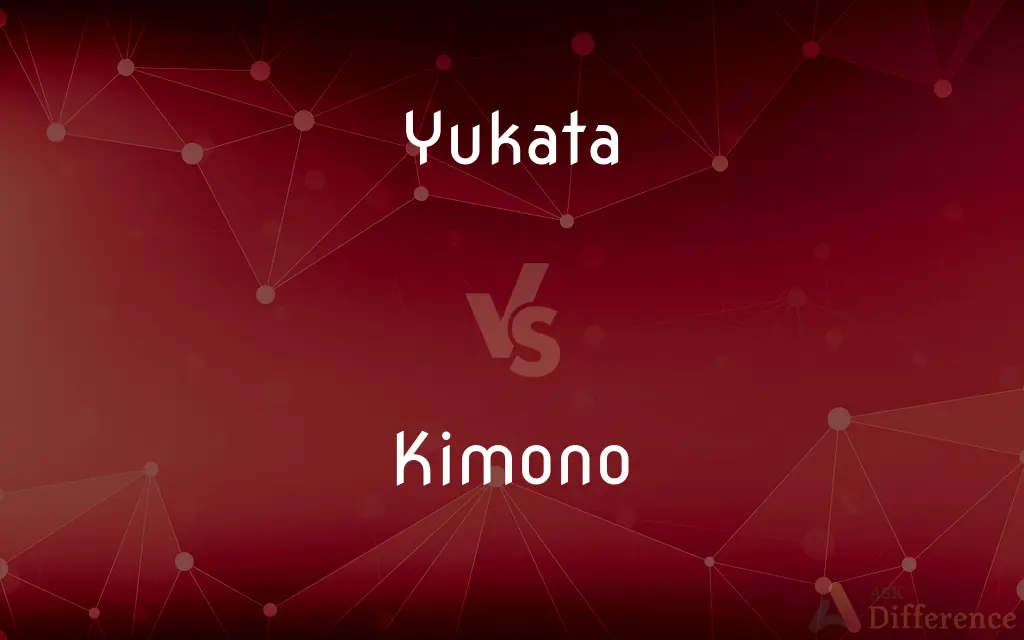Yukata vs. Kimono — What's the Difference?
By Fiza Rafique & Urooj Arif — Updated on March 9, 2024
Yukata are casual, cotton summer robes worn at festivals, while kimonos are formal, often silk, garments for special occasions.

Difference Between Yukata and Kimono
Table of Contents
ADVERTISEMENT
Key Differences
Yukata, traditionally worn during the summer, especially at festivals and hot springs, are made from lightweight cotton. They are characterized by their bright, colorful designs and are often considered a more casual form of traditional Japanese wear. Kimonos, on the other hand, are made from various materials, including silk, and are considered formal wear. They are often worn for special occasions such as weddings, tea ceremonies, and other cultural events.
Yukatas are easier to wear and more comfortable in the hot Japanese summer, making them popular among both men and women of all ages. The kimono is known for its intricate designs, multiple layers, and can be accessorized with various traditional items such as the obi (a wide belt), zori (sandals), and tabi (split-toe socks). Wearing a kimono properly requires knowledge of specific techniques and is often seen as an art form.
While yukatas are relatively simple to put on and can be worn without assistance, kimonos often require the help of a professional or an experienced person due to their complexity. The process of putting on a kimono involves precise steps, including how to fold and wrap the garment, how to tie the obi, and the order of layering various pieces.
In terms of occasions, yukatas are typically worn in informal settings such as summer festivals (matsuri), fireworks (hanabi), and other casual gatherings. Kimonos, with their formal and sophisticated nature, are reserved for significant and ceremonial events, showcasing the wearers' respect for tradition and culture.
The choice between a yukata and a kimono often depends on the occasion, the season, and personal preference. While a yukata offers a more relaxed and colorful option for summer events, a kimono provides an elegant and formal attire suitable for important cultural and family occasions.
ADVERTISEMENT
Comparison Chart
Material
Cotton or synthetic fibers
Silk, linen, or other high-quality fabrics
Occasion
Casual, mainly in summer and at festivals
Formal events, ceremonies
Complexity
Simple to wear, no assistance needed
Complex, often requires assistance
Designs
Bright, colorful, less intricate
Elaborate, often with significant symbolism
Accessories
Minimal, often just a simple obi
Numerous, including obi, zori, tabi
Compare with Definitions
Yukata
A casual Japanese summer robe made of cotton.
She wore a vibrant blue yukata to the summer festival.
Kimono
Made from luxurious fabrics like silk.
The kimono's silk fabric had a delicate crane design.
Yukata
Lightweight and worn during hot weather.
The light fabric of the yukata was perfect for the humid evening.
Kimono
Involves a complex wearing process.
Dressing in a kimono required the help of an experienced dresser.
Yukata
Often adorned with simple patterns.
Her yukata had a beautiful floral pattern that was eye-catching.
Kimono
Often paired with an obi belt.
The obi belt added a stunning contrast to her kimono.
Yukata
Typically worn at festivals and fireworks.
Everyone was dressed in colorful yukatas at the matsuri.
Kimono
A traditional Japanese garment worn for formal occasions.
She wore an exquisite silk kimono to the tea ceremony.
Yukata
A more informal traditional wear.
He chose a yukata for the casual gathering by the river.
Kimono
Symbolic designs and patterns.
His kimono featured an intricate pattern that represented longevity.
Yukata
A yukata (浴衣, lit. "bathrobe") is an unlined cotton summer kimono, worn in casual settings such as summer festivals and to nearby bathhouses.
Kimono
The kimono (きもの/着物, lit., "thing to wear" – from the verb "to wear (on the shoulders)" (着, ki), and the noun "thing" (物, mono)) is a traditional Japanese garment and the national dress of Japan. The kimono is a T-shaped, wrapped-front garment with square sleeves and a rectangular body, and is worn left side wrapped over right, unless the wearer is deceased.
Yukata
A lightweight informal kimono, usually made of cotton.
Kimono
A long, wide-sleeved Japanese robe worn with an obi and often elaborately decorated.
Yukata
A kind of light kimono worn by both men and women.
Kimono
A loose, light robe worn chiefly by women.
Kimono
A traditional Japanese T-shaped, wrapped-front garment with square sleeves and a rectangular body, now generally worn only on formal occasions.
Kimono
(loosely) A yukata.
Kimono
A long robe-like garment in Western fashion, which may be open at the front, loosely inspired by the Japanese garment.
Kimono
(regional) A bathrobe or dressing gown.
Kimono
A kind of loose robe or gown tied with a sash, worn as a traditional outer garment by Japanese women and men. Women may wear it with a broad sash called an obi, having a large bow in the back. At present (1998), most Japanese wear it only at home or on ceremonial occasions, western-style clothing being more common in the workplace.
Kimono
A similar gown worn as a dressing gown by women of Western nations.
Kimono
A loose robe; imitated from robes originally worn by Japanese
Common Curiosities
Can a yukata be worn to formal events?
Typically, yukatas are considered too casual for formal events, where a kimono would be more appropriate.
What is the main difference between a yukata and a kimono?
The main difference lies in their formality, material, and occasions for wear; yukatas are casual cotton robes for summer events, while kimonos are formal, often silk garments for special occasions.
Are there specific occasions when wearing a kimono is expected?
Yes, kimonos are often worn during traditional ceremonies like weddings, tea ceremonies, Coming of Age Day, and other formal cultural events.
How do the seasons affect the choice between yukata and kimono?
Yukatas are typically worn in the summer due to their lightweight material, while kimonos can be worn year-round, with fabric and layers adjusted for the season.
Is it difficult to wear a yukata?
No, yukatas are relatively simple to put on and do not usually require professional assistance, unlike kimonos.
Can men wear yukatas and kimonos as well?
Yes, both yukatas and kimonos are worn by men and women, although the designs and styles may differ.
How do the patterns on yukatas and kimonos differ?
Yukata patterns tend to be brighter and less formal, often featuring summer motifs, whereas kimono patterns can be more intricate and symbolic, reflecting season, occasion, and wearer's status.
Are kimonos only made from silk?
While silk is traditional and common, kimonos can also be made from other high-quality fabrics such as linen.
Can yukatas and kimonos be worn outside of Japan?
Yes, both garments can be worn outside of Japan, especially at Japanese cultural festivals, cosplay events, or in cultural appreciation settings.
How does one care for and maintain a kimono?
Kimonos require careful maintenance, including proper folding, storage away from sunlight, and occasional airing. Silk kimonos may need professional cleaning.
Is it acceptable for non-Japanese individuals to wear yukatas or kimonos?
Yes, it is generally considered acceptable and appreciated when non-Japanese individuals respectfully wear yukatas or kimonos, especially at cultural events or festivals.
What accessories are commonly worn with kimonos?
Common accessories include the obi (belt), zori (sandals), tabi (split-toe socks), and sometimes haori (jacket) or hakama (pleated skirt/trousers).
How has the popularity of yukatas and kimonos changed over time?
While traditional wear has declined in daily use, both yukatas and kimonos remain popular for special occasions and cultural events, with a resurgence in interest for traditional and modern interpretations.
What are some common misconceptions about yukatas and kimonos?
Common misconceptions include that they are interchangeable, always made of silk, or that they are only for women. In reality, they have distinct uses, materials, and are worn by all genders.
Are there different types of obi for yukatas and kimonos?
Yes, there are various types of obi, with simpler versions typically worn with yukatas and more elaborate, structured obi reserved for kimonos.
Share Your Discovery

Previous Comparison
Shaft vs. Gear
Next Comparison
Title vs. AddressAuthor Spotlight
Written by
Fiza RafiqueFiza Rafique is a skilled content writer at AskDifference.com, where she meticulously refines and enhances written pieces. Drawing from her vast editorial expertise, Fiza ensures clarity, accuracy, and precision in every article. Passionate about language, she continually seeks to elevate the quality of content for readers worldwide.
Co-written by
Urooj ArifUrooj is a skilled content writer at Ask Difference, known for her exceptional ability to simplify complex topics into engaging and informative content. With a passion for research and a flair for clear, concise writing, she consistently delivers articles that resonate with our diverse audience.
















































